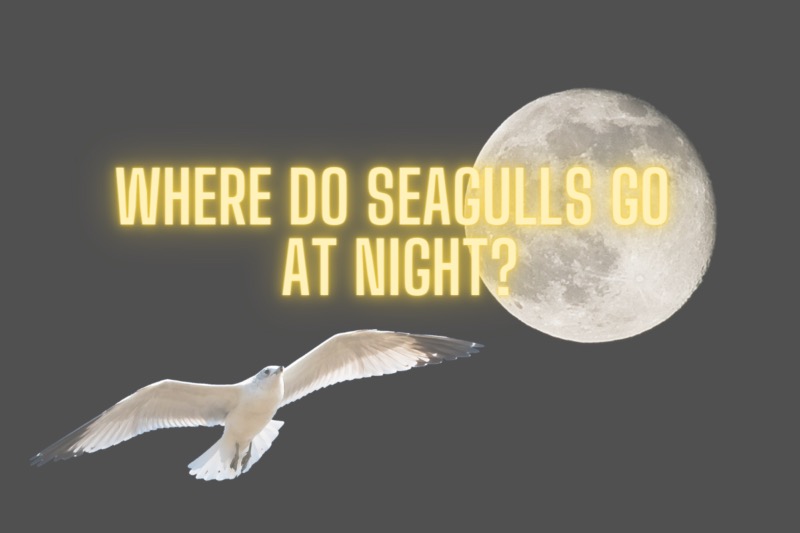“Seagull” is a colloquial term that refers to a large number of gull species. There are 28 different gull species found in North America, which are spread throughout the coasts, inland areas and areas around fresh water.
Seagulls usually sleep in colonies of the same species and have a sophisticated sleep system to help protect against predators. The seagulls will take cues from their neighbours while sleeping to determine whether it is safe to sleep or not.
Have you ever wondered what birds like seagulls do at night? Where they sleep? If they sleep? In this post we will look into the nighttime whereabouts of seagulls!
Contents
Where and How Do Seagulls Sleep?
Since there are so many different species of gull, there are some slight variations in behaviour based on the species of gull and the location of their habitat.
Seagulls live in colonies that can reach several hundred thousand birds in size, which helps to protect themselves from predators.
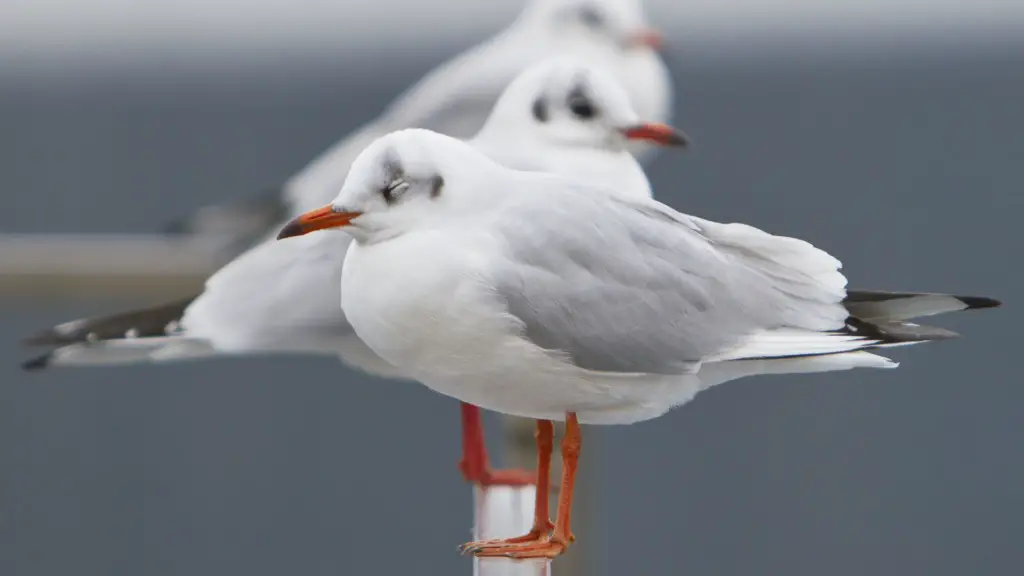
They will sleep more soundly if their neighbours are also asleep, but become alert when their neighbours wake up.
Additionally, gulls sleeping at the centre of the colony get more sleep on average than gulls sleeping on the edge of the colony.
Seagulls on the edges need to be more alert for predators, while those in the centre have the luxury of being more relaxed since they are more protected.
As a result of this phenomenon, when observing seagulls sleeping, you can see waves of sleeping and waking rippling through the flock as the birds take cues from each other.
Sleeping reduces the ability of seagulls to detect potential threats and predators, therefore seagulls in a flock can’t all be asleep at the same time, or they run the risk of predators catching them unawares.
While “sleeping”, gulls alternate between having their eyes open and closed to monitor their neighbours and any signs of predators.
Seagulls experience unihemispheric slow-wave sleep (USWS), which means the gulls will sleep with half their brain awake, with the other half asleep.
This helps to enable them to both sleep and maintain a state of alertness for predators. Seagulls experience both non-rapid eye movement (non-REM) and rapid eye movement (REM) sleep cycles, but both cycles are shorter than in humans.
This helps protect the flock as a whole and seagulls will use a variety of vocalizations to communicate to other members of the colony if there is danger.
Colonies of gulls most often form on beaches, marshy hummocks, isolated islands or rooftops, and a variety of other areas. They are omnivores and are known particularly as scavengers, eating just about anything they can find.
When do Seagulls Sleep?
Seagulls, like many other birds, are diurnal animals, which means they are active during the day and sleep at night. However, seagulls can be active during the night if they are in an area where there is an abundant source of light, noise, traffic or food, such as in urban areas.
While seagulls are mostly inactive at night, they can be found flying around at night for specific reasons.
Seagulls living in urban areas with higher human populations, light, and food sources have resulted in greater night activity than in their natural environments.
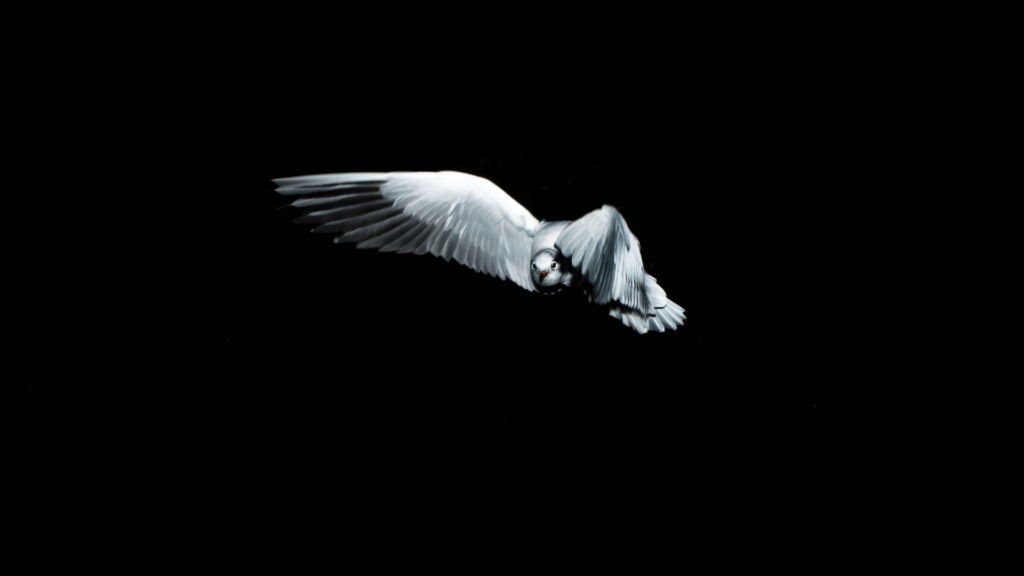
During the day, seagulls may take short naps while standing or floating on the water, but they usually do not sleep for long periods like humans do. They need to remain alert to avoid predators and to find food.
When it is time for seagulls to rest, they may perch on a rock, a tree, or even on a building or a boat. They may also sleep while floating on the water, with one eye open to keep watch for potential threats.
This behavior is known as unihemispheric slow-wave sleep, where one half of their brain is awake while the other half is asleep. This allows them to rest while remaining alert to their surroundings.
They may fly at night to avoid predators, or even scavenge for food when no one is around. Seagulls can eat insects, small rodents, reptiles, amphibians, seeds, fruit, and are especially known for scavenging human leftovers.
Their predators include large birds of prey, like eagles, and small to medium-sized mammals, like foxes.
So, when we refer to seagulls ‘sleeping’, they are actually really only half-asleep to maintain some level of alertness to watch out for predators.
Where do Seagulls Nest at Night?
When birds go to sleep or roost, the most important factors are for the bird to be safe and warm.
Unlike pigeons and doves that prefer to nest alone or in pairs in shrubs or trees, seagulls are more social and connected to the sea.
Seagulls roost in large flocks in a huge variety of habitats, but they prefer areas with limited human activity like rocky cliffs, rocky or isolated shorelines, a clearing with tall grass, abandoned buildings and sand dunes.
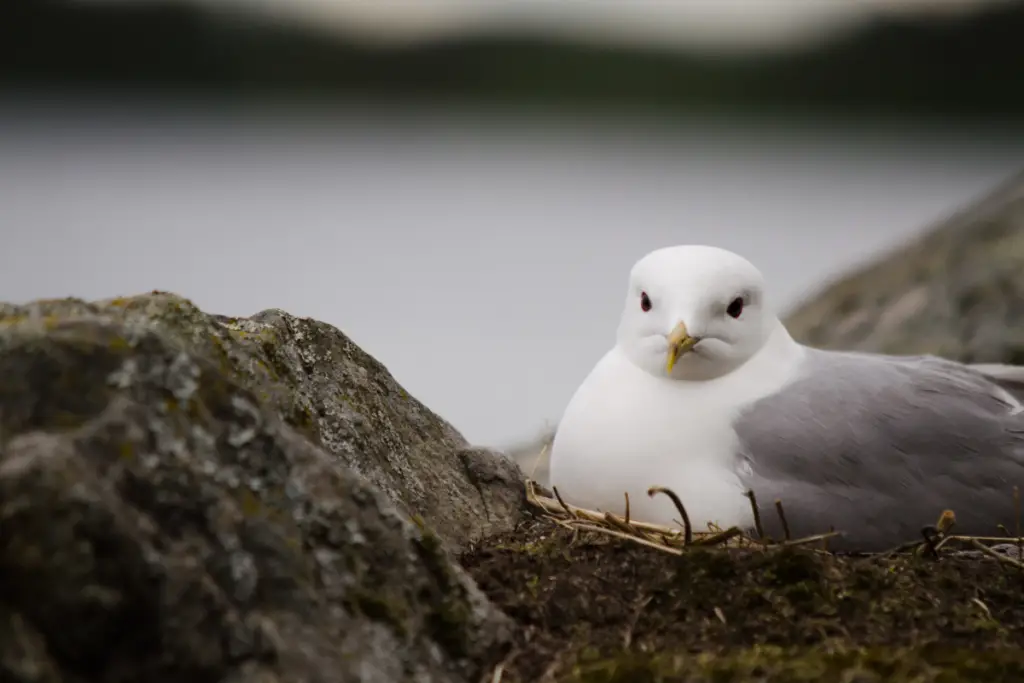
They will also choose to roost at night in open areas with good visibility for spotting predators. These areas include piers, agricultural fields, beaches, sport fields, sandbars, parking lots, garbage dumps, lakes, airport runways, water when its calm, and rooftops.
They won’t go to their roosting site until they are truly ready to sleep.
Some species of gull, like Bonaparte’s Gull, have even been known to roost in trees.
There is one notable exception, which is the Swallow-tailed gull, which is nocturnal and will feed all night. But most seagulls at night will find somewhere to roost and sleep.
It is a common misconception that birds use nests for sleeping at night. If it is nesting season, the seagulls will remain at the nesting site to protect their young.
A recent study on Black-headed gulls found that on average, the birds were active 41.8% of the night, spent on passive and active nest defence.
While they don’t need their nests for sleeping, seagulls do need to lay their eggs in nests and can breed between March and June, but this varies depending on species and location.
The breeding pair builds the nest together, collecting twigs, grasses, feathers, and other plant material. The nest is built into a cup shape and located on the ground or on cliffs.
Nesting sites are incredibly varied due to the variety in seagull habitat, but can include sea cliffs, sand dunes, islands, sand bars, and rooftops.
Seagulls nest in large, densely packed colonies, but have their own individual nesting territory within the colony they will protect from other gulls.
Seagulls will usually return to the same colony and location to breed, and depending on the species, may even reuse the same nest.
Where do seagulls sleep when it rains?
Seagulls can fly in the rain and during storms, but it’s more difficult and requires more energy as they have to deal with wind and changes in air pressure.
This higher energy requirement for flying means they would need more food, which is not readily available, as food is more difficult to find in these conditions.
As a result, seagulls will usually move inland or out of the storm’s path to get shelter and wait out the storm. They will find shelter in bushes and trees, and similarly to their night-time routine, will stay motionless to conserve energy.
Similarly to when they roost at night, during storms seagulls will also find shelter and huddle together in groups.
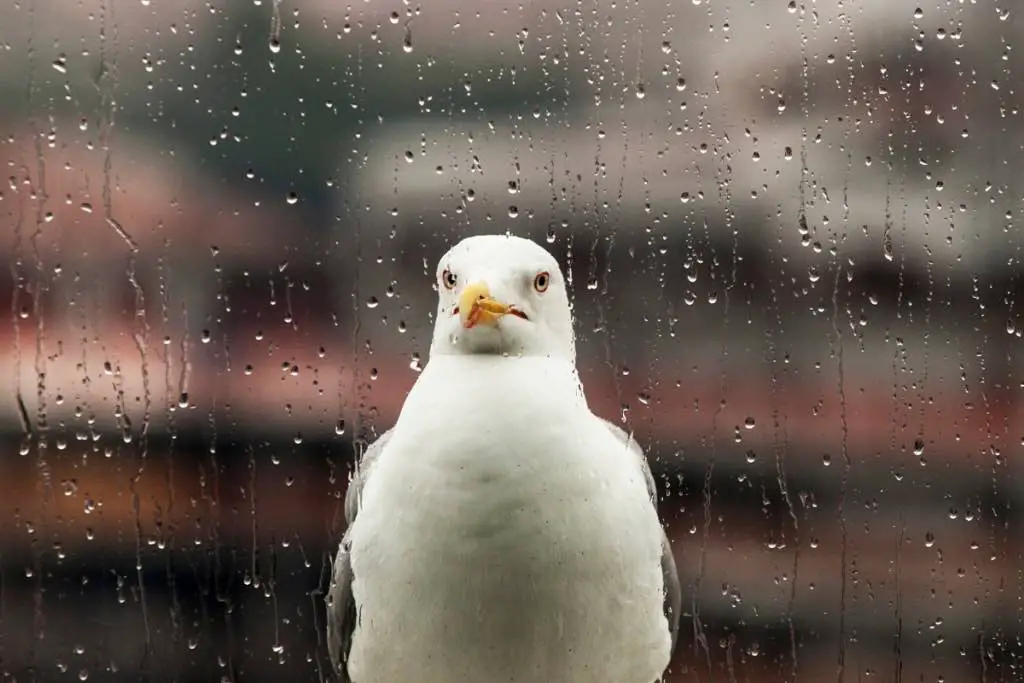
During light rain, most birds will continue with their normal activities because they have waterproof feathers, due to oil from the preen glands, which prevent them from getting drenched and soggy.
During more intense storms or strong winds, smaller birds will seek shelter inland. Seagulls can sense the storm front moving in days in advance, and will often head inland or out of the storm’s path for protection from the elements.
Humans often use seagulls and other seabirds as a forewarning of incoming storms, as their flight or absence is often an indicator of an impending storm.
This is because seagulls can sense the changes in air pressure, like a barometer, that indicate a storm is brewing.
Just like when choosing where to sleep at night, choosing where to sleep during a storm requires the birds to be extra careful, as they have to find somewhere that protects them from the elements and predators.
Do seagulls sleep standing up?
Seagulls can usually be found sleeping in one of two positions: standing on one leg with the other leg tucked into the belly or crouching.
They will often tuck their bill into the neck feathers or under the scapulars. All of these positions are done standing on one leg, crouching, with their head tucked into feathers all work to help maintain body heat and protect against colder temperatures.
There is a specific reason why tucking one leg into the body is so advantageous for seagulls to maintain their body temperature.
They have unique veins in their legs called rete mirabile that minimize heat loss. Arteries carry warm blood from the heart into the legs, and these arteries are directly next to the veins that return the cooled blood back to the heart (to be warmed up again).
Since they are so close together, the arteries help warm the cooler blood in the veins, making the bird warmer overall.
By standing on one leg and tucking the other into the body, they are also using their body heat to keep the tucked leg warmer through direct contact with the bird’s body.

By standing on one leg and tucking the other leg into the body, seagulls can reduce their heat loss by up to 50%.
This is also the position often taken up by seagulls when loafing during the day. Loafing is when seagulls appear relaxed, sleeping or preening.
Loafing sites can include open areas with good visibility, like fields, beaches, and water. Seagulls spend a lot of their day loafing, when they are not scavenging for food. Loafing sites are different from roosting sites.
Can Seagulls see in the Dark?
In short, most seagull species don’t have ‘night vision’ and are unable to see or operate in total darkness.
As a result, gulls can see and fly at night as long as there is some form of light for them to see by.
However, many habitats where seagulls live are rarely completely devoid of light due to human activity and light pollution, or even just the moon.
The exception to this is the Swallow-tailed gull, which is the only fully nocturnal gull and seabird in the world.
The Swallow-tailed gull has night vision due to two unique features: they have the largest eyes by size and volume of all gull species, and they have a tapetum lucidum.
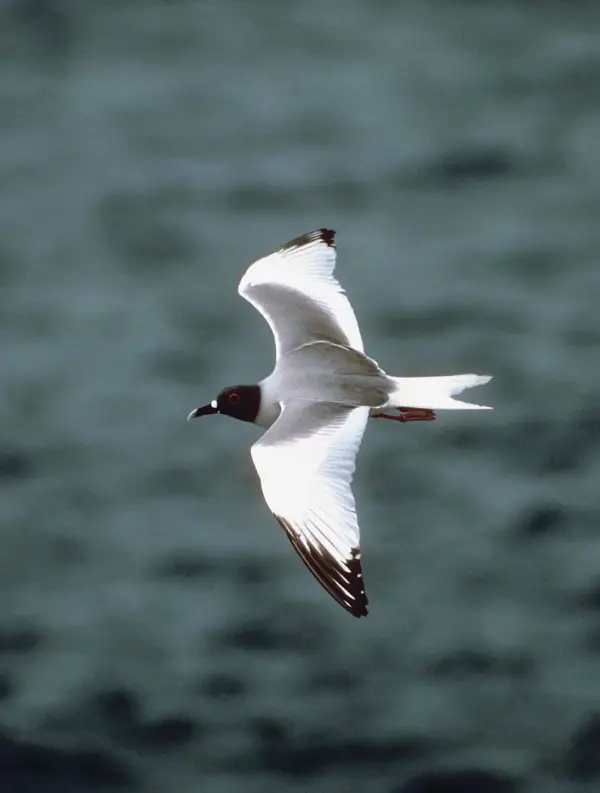
The tapetum lucidum is a layer of tissue on the eye that reflects visible light back through the retina, which allows it to see in low-light conditions.
The tapetum lucidum is common in vertebrates, particularly nocturnal ones, and can easily be identified by eyeshine. Eyeshine is when the pupils of the animal appear to be glowing when light shines into the eyes.
During the daylight hours, seagulls have better vision than that of humans, and are unique in that they are one of the few bird species that can move their eyes in their sockets.
Gulls can see in colour, and generally see more colours than humans, which is due to the number of cones in the eye. Cones are responsible for colour vision.
Humans have 3 types of cones, allowing our brains to interpret the three primary colours: red, green, and blue. Seagulls have four cones, the fourth of which enables them to see infrared colour, which humans cannot see.
For example, the sky appears blue to humans, whereas seagulls would see a more violet colour instead.
References
Beauchamp G. Collective Waves of Sleep in Gulls (Larus spp.). Ethology. 2011;117(4):326-331. doi:10.1111/j.1439-0310.2011.01875.x.
Indykiewicz, P., Jakubas, D. & Gerke, J. Gulls of a feather do not sleep whenever—circadian rhythm of activity of black-headed gulls Chroicocephalus ridibundus during the incubation period. J Ornithol 162, 1101–1114 (2021). https://doi.org/10.1007/s10336-021-01896-8
https://www.birds-of-north-america.net/gulls.html

